

| 第1回公開シンポジウム 有楽町朝日ホール スクエア(東京) 平成21年2月12日(木) 9:45~17:45 『日英ブレイン・マシン・インターフェース国際ワークショップ (課題A,B公開シンポジウム)』 プログラムはこちら |
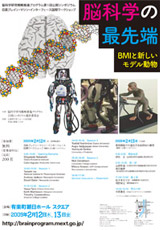 |
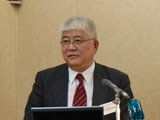 |
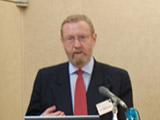 |
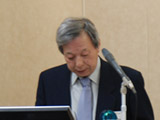 |
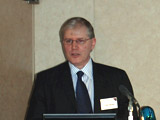 |
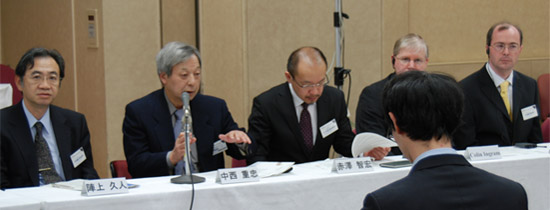
| Tadashi Isa (Department of Developmental Physiology, National Institute for Physiological Sciences) Functional electrical stimulation (FES) of the spinal cord is expected to work as an effective neuroprosthetisto compensate the motor function of the patients with spinal cord injury at the higher cervical level or brainstroke, with which the difficulty of FES of skeletal muscles, such as muscle fatigue, could be overcome.However, for this purpose, it is essential to understand the neuronal organization of the premotor interneu-ronal circuits of the spinal cord and primary effects of FES of the spinal cord circuits. In addition, develop-ment of flexible electrodes is also necessary to minimize the mechanical damage and induction of gliosis ofthe spinal tissue during the long term implantation. In this presentation, I will present the data of our recent experiments on non-human primate preparations inwhich we tested the spatio-temporal pattern of interactions between motor sites in the cervical spinal cordand long-term stability of the stimulating electrodes. |
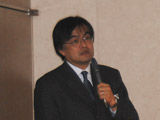 |
| Stuart Baker (Institute of Neuroscience, Newcastle University) Andrew Jackson (Institute of Neuroscience, Newcastle University) Implanted devices that relay electrical signals directly to and from the nervous system may form the basis offuture neural prostheses to restore function following spinal cord injury and other neurological conditions.However key technical and scientific challenges must be overcome before electronics can be successfullyintegrated with the brain. In this talk we will discuss progress in several areas. First, advanced microfabrica-tion techniques are enabling a new generation of electrodes for chronic implantation into nervous tissue withimproved long-term performance. Second, low-power autonomous electronic implants implementing contin-uous bidirectional interfaces with the nervous system are providing new insights into plastic reorganisationof neural circuits. Such plasticity is likely to be crucial for the successful operation of neural prostheses, andmay have a beneficial role in rehabilitation following injury. |
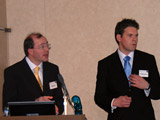 |
| Takashi Fujikado (Department of Visual Science, Osaka University Medical School) Yasuo Tano (Department of Ophthalmology, Osaka University Medical School) For the last few decades, ophthalmologists, visual scientists and medical engineers have closely been col-laborating in quest of realization of clinically applicable visual prosthesis which would benefit blind patientsof outer retinal disorders such as retinitis pigmentosa. We have been developing a unique visual prosthesiswith suprachoroidal transretinal stimulation (STS) system since 2001 when the consortium of the JapanArtificial Vision Project was organized. Validity of the STS system has been assessed by various aspectssuch as studies on efficacy, safety and stability in animal eyes, evaluation of spatial resolution by the sys-tem, development of animal models of retinal degeneration, neuroprotective effect by transcorneal electricalstimulation, acute human clinical trial and so forth. We have constructed prototype of a visual prosthesiswith STS system. Currently preclinical studies are being conducted in expectation to produce a commercial-ly-available visual prosthesis with STS system in the near future. |
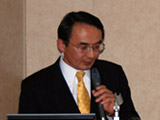 |
| Keith Mathieson (Retinal Prosthesis Group, Glasgow University) Degenerative photoreceptor diseases, such as age-related macular degeneration and retinitis pigmentosa,are the most common forms of blindness in the developed world. There has been world-wide interest indeveloping a retinal prosthesis for these diseases by electrically activating the retinal output (ganglion) cells. We have developed a system to detect the visual scene and translate the image into a train of electricalpulses that stimulates retinal tissue. The imaging device is a CMOS pixel sensor with over 500 pixels fabri-cated in a 0.35 micron CMOS process. Each pixel contains a photodiode and on-pixel circuitry that trans-lates the intensity of the incoming light into a certain frequency of output current pulses. The sensor includesan on-chip neural network that replicates the biological process of lateral inhibition, by suppressing areas oflike contrast. The outputs of the pixels are connected to a biocompatible microelectrode array which makescontact with the retinal cells. |
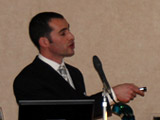 |
| Timothy Constandinou (Institute of Biomedical Engineering, Imperial College London) With ever decreasing electrode-nerve interface proximities, typical stimulus magnitudes for neural activationare decreasing and, therefore, the bottleneck in the power budget of implant devices is now the signal pro-cessing. Commercial cochlear implant systems overcome this challenge by incorporating a two modulesolution encompassing an implanted stimulator and external auditory processing hardware. Recentadvances in ultra low power microelectronics, however, have now presented new opportunities for imple-menting totally implantable solutions. Sensory artificial prostheses are ideal candidates to exploit such tech-niques, building on the success of cochlear implants. Two such examples of recent advances will be pre-sented. Firstly, a 16-channel, fully-programmable, mixed-signal cochlear prosthesis, with total power con-sumption of 126 μW. Secondly, a new emerging neuroprosthetic device for the restoration of balance is thevestibular prosthesis. We will present the world’s first such integrated system, based on a hybridCMOS/MEMS implementation of a 5-channel prosthesis. |
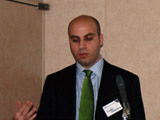 |
| Toshiki Yoshimine (Department of Neurosurgery, Osaka University Medical School) High quality neural signals are acquirable with a set of electrodes implanted beneath the skull, directly on thesurface of the brain (subdural electrodes). By decoding those signals, we may conjecture the content ofsome brain activity. We recently succeeded to discriminate several types of hand movement by decodingthe signals obtained from a specific area of the brain (primary motor cortex). The instantaneous decodingenabled real-time activation of a robotic arm. Although implantation of the electrodes is partially invasive, the quality of signals obtained is far superior tothose obtained over the scalp. The clinical risk is relatively low. A multidisciplinary cooperative project islaunched to develop clinically applicable system of this type of brain-machine interface (BMI) to help peoplesuffering from severe motor disabilities. |
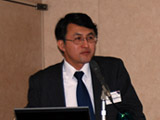 |
| Avgis Hadjipapas (The Wellcome Trust Laboratory for MEG Studies, The School of Life and Health Sciences, Aston University) Our recent studies show that information about the structure of the static visual world can be decoded fromthe spectral patterns of gamma oscillations in the human MEG. Crucially, stimulus decoding is still possiblewhen only utilizing the sustained part of the oscillations. We introduce single-trial measures of stimulus-specificity (using SVM-methodology) and observe a parametric dependence of the degree of specificity inepochs that immediately precede stimulus-change and subsequent behavioural and evoked responses. Theresults are robust but somewhat counterintuitive: if the spectral pattern in the preceding epoch is typical forthe subsequent stimulus class, then behavioural responses are accelerated and evoked transients facilitat-ed; analogously, if the pattern is typical for a class of stimuli different to the subsequent stimulus, the con-verse occurs. These results are consistent with a mechanism embodied in the gamma network state, whichmonitors sensory constancy and provides a reference frame for sensory changes. |
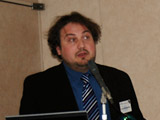 |
| Yoshiyuki Sankai (Leader of Global COE “CYBERNICS”, Graduate School of Systems and Information Engineering, University of Tsukuba) Cybernics is a new domain of interdisciplinary academic field of human-assistive technology to enhance,strengthen, and support human's cognitive and physical functions, which challenges to integrate and har-monize humans and robots (RT: robotics technology) with the basis of information technology (IT) in a func-tional, organic, and social manner. We aim to develop the frontier science Cybernics, which is centered oncybernetics, mechatronics, and informatics, and it challenges to integrate neuroscience, robotics, systemsengineering, information technology, “kansei” engineering, ergonomics, physiology, social science, law,ethics, management. The goal of the Program represents a Grand Challenge that makes breakthroughs in the innovative creation and fusion of forefront researches based on information science. In this talk, I willdeliver the outline Cybernics approach based on our experienced and introduce the work performed inCybernics. And, I may present BMI / BCI what we have done related in this fields. |
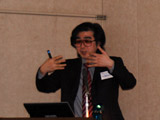 |
| Nick Donaldson (Department of Medical Physics and Bioengineering, University College London) Recently in Europe, funding of research into neuroprosthetics has been available with expectations that suc-cessful technological development will lead to new industrial products and higher quality of life for disabledpeople. Perhaps the rise of the cochlear implant has been the outstanding example of such development. Anold idea is that people who have been disabled by spinal cord injury might have leg function restored usingnerve stimulators. Yet despite considerable research effort in the last 40 years, very few patients are actuallygiven stimulation devices during their rehabilitation. Professor Donaldson will explore some of the reasonsfor this poor outcome, based on his experience. Understanding these difficulties may help those who wish todevelop other types of neuroprosthesis including those with Brain-Computer Interfaces. |
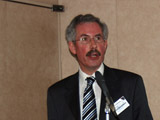 |
| Mitsuo Kawato (ATR Computational Neuroscience Laboratories, Research Supervisor of ICORP Computational Brain Project, JST) Brain-computer interfaces (BCI), brain-machine interfaces (BMI), and brain-network interfaces (BNI) are revo-lutionary new man-machine interfaces that directly connect brains and computers, robots and/or internetsbypassing sensory and motor organs. These interfaces are expected as one of the most promising and influ-ential application fields of the system neuroscience, and also expected to provide an entirely new experi-mental paradigm that guarantees cause-and-effect analyses for the system neuroscience, unlike usualexperimental efforts demonstrating mere temporal correlations between hypothetical variables and neural orbrain activities. For further developments of BCI, BMI and BNI, many conceptual,technical and computa-tional problems should be resolved. Examples are neuroethics, high spatiotemporal resolution non-invasivebrain measurement technology (Kawato), artificial neural circuits that are embedded in the biological nervoussystem (Fetz), electrocorticogram-based low-invasive BMI (Kato), BMI based neuro-rehabilitation (Isa), rigor-ous proof of computational theories based on BNI (Kawato). This symposium highlights recent advances inthese emerging problems in BCI, BMI and BNI by lectures of 5 leading scientists in this field. |
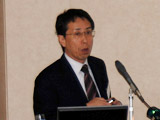 |
| 私を含め、多くの人は、自分自身を含めた「ヒト」の認知・情動行動の科学的理解や脳精神疾患の原因と治療に関心を持っていると思うが、そうした興 味と関心 に科学的に答える為には、モデル動物の選択がその成功の可否を決定する一つの重要な要因である。例えば、神経活動の伝導機構の研究に於いては、ヤリイカの 巨大神経が、神経伝達物質の受容体に遺伝子の同定と機能解明には、アフリカツメガエルの卵母細胞が用いられて、神経活動の素過程の解明に重要な役割を果た してきた。そこで、本講演では、高次脳機能に重要な役割を果たす霊長類大脳新皮質における遺伝子発現の最近の研究の幾つかについて紹介し、哺乳類のモデル 動物の代表であり、脳科学に於いても,最も良く用いられるマウスと霊長類の遺伝子発現の異同を示したい。その上で、霊長類を用いた脳研究の重要性と可能性 について論じてみたい。 | 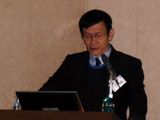 |
| 近年、ウイルスベクターを用いた遺伝子導入技術により、高次脳機能を解明しようとする研究や、神経変性疾患に対する遺伝子治療法を開発しようとす る研究が 注目を集めている。このような研究を展開していく上で、ヒトに近縁のサルを使用することが必要不可欠であることは言うまでもない。本講演では、私の研究グ ループが現在進めている、アデノウイルス、アデノ随伴ウイルス、レンチウイルス由来の組換え体ウイルスベクターを用いた遺伝子導入により、パーキンソン病 に対する新たな遺伝子治療法の開発を目指した基礎的研究の成果を紹介したい。本研究で試みた遺伝子治療戦略は、パーキンソン病の責任細胞である黒質ドーパ ミン細胞にその変性・脱落を抑制するような機能分子であると考えられるカルビンディン(カルシウム結合蛋白)やパーキン蛋白(ユビキチンリガーゼ)の遺伝 子導入を行い、パーキンソン病の発症を防御することである。 | 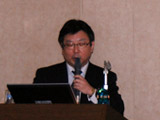 |
| マウスでは様々な発生工学的手法が確立し、現在までにトランスジェニック動物、標的遺伝子のノックアウト/ノックイン動物など多くの遺伝子改変動 物が作出 され、ヒト疾患のモデル動物として、疾患の発症メカニズムの解明、治療法の開発などに貢献している。しかしながら、マウスとヒトの間には生理的・機能的・ 形態的な違いが多くあり、げっ歯類を用いた動物実験だけでは、新規治療法の開発においてその治療効果・安全性を予測するには不十分であり、よりヒトに近い ヒト疾患実験動物が必要である。特に精神・神経病の研究分野においては、よりヒトに近い動物種による疾患モデルの作出が望まれている。霊長類の実験動物は 数種類あるが、中でもコモンマーモセットは、繁殖力が高いこと、小型で扱い易いこと、性成熟が早いことなどから、遺伝子改変による疾患モデル動物作出に最 も適していると考えられる。マーモセットを用いた遺伝子改変動物を作製するためには、その基礎となる採卵、体外受精、胚培養、遺伝子改変法などの様々な発 生工学研究が重要となる。マーモセットでこれらの発生工学的技術を確立する場合、特に倫理的・経済的な観点から、生体より試料を採取できること、なるべく 非侵襲的であることが望まれ、また小型であるため、独自の手法の工夫が必要となっている。我々が現在までに取り組んできた遺伝子改変マーモセット作出に向 けたマーモセットの発生工学研究の取り組みについて紹介する。 |
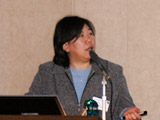 |
| 我々は、霊長類コモンマーモセットを用いた中枢神経系のMR画像解析を行っている。すでに我々は、マーモセットMR脳アトラスを2008年に発刊 したが、 今回はdiffusion tensor tractography(DTT)とq-spaceimaging(QSI)に注目し、マーモセットの脊髄損傷に対するこれらの撮像法の有用性を検討し てきた。DTTによりサル脊髄半切損傷における軸策の切断部の明瞭な描出、さらには圧挫損傷においても損傷部をよけて白質の辺縁を走行する軸索の描出に成 功し、これら描出された神経線維数と運動機能の回復に相関があることを明らかにした。本結果より、DTTは脊髄損傷の程度や損傷を免れた軸索の変化を表し ており、ヒト脊髄損傷に対してもDTTが有力な評価方法になりうる可能性が示唆された。QSI法は、水分子の拡散変異分布から制限構造のサイズをμm単位 で推定することが可能であり、この情報を可視化したdisplacement mapは顕微鏡的MRIといえる。マーモセット脊髄損傷モデルの測定により、QSIは灰白質の破壊や空洞形成、脱髄を鋭敏に捉えていた。われわれ独自の Myelin enhanced mapは、髄鞘染色を正確に反映していた。これらの結果から、従来組織学的に評価せざるをえなかった脊髄の組織変化を非侵襲的に知ることが可能となった。 | 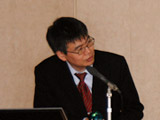 |